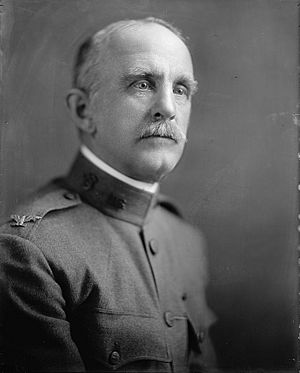Isaac Littell facts for kids
Quick facts for kids
Isaac William Littell
|
|
|---|---|
 |
|
| Born | 5 December 1857 Elizabeth, New Jersey, US |
| Died | 1 May 1924 (aged 66) Walter Reed General Hospital, Washington, DC, US |
| Buried |
Arlington National Cemetery Section 3, Grave 3948
(38°52′25″N 77°04′19″W / 38.873651°N 77.071840°W) |
| Allegiance | |
| Service/ |
|
| Years of service | 1883–1919 |
| Rank | |
| Service number | 0-13124 |
| Awards |
Army Distinguished Service Medal
|
Isaac William Littell (born December 5, 1857 – died May 1, 1924) was an important United States Army officer. He reached the rank of brigadier general, which is a high-ranking military leader. He earned the Army Distinguished Service Medal for his excellent work during World War I. This award recognized his efforts in building many of the Army's camps and training areas in 1917. He led the Cantonment Division of the Quartermaster General's Office, which was in charge of these huge building projects.
Contents
Early Life and Military Start
Isaac Littell was born in Elizabeth, New Jersey, on December 5, 1857. He attended the United States Military Academy, also known as West Point. This is a famous school where future Army officers are trained. He graduated in 1883, doing very well in his class. Many of his classmates also became important generals later on.
After graduating, he became a second lieutenant. He was assigned to the 10th Infantry unit. During this time, he served in different parts of the United States, including Colorado, Indian Territory, New Mexico, and Oklahoma Territory.
Joining the Quartermaster Corps
After five years in the infantry, Littell moved to the Quartermaster Corps. This part of the Army is responsible for supplying troops with everything they need, like food, clothing, and equipment. They also manage transportation and housing.
In 1895, he was promoted to captain. He served as the quartermaster at Fort Sam Houston in Texas. His job was to make sure the soldiers there had all their supplies.
Service in New York and the Philippines
In 1897, Captain Littell moved to the Quartermaster Depot in New York City. Here, he helped manage supplies for the Army. A big task came in 1898, when the U.S. Army was getting ready for the Spanish–American War. Littell was in charge of getting all the clothing for the new Army units that were being formed.
From 1899 to 1902, he served in the Philippines. He worked as a quartermaster for different units there, making sure they had what they needed during the conflict. During this time, he was promoted to major.
Working in Washington, D.C.
After his time in the Philippines, Littell returned to the United States. From 1903 to 1908, he worked in the Quartermaster General's office in Washington, D.C.. He was promoted to lieutenant colonel in 1908. His duties included managing clothing, repairs for barracks and roads, and transportation for the Army.
Later, he served as the chief quartermaster for the Eastern Division of the Army, located on Governors Island in New York. In 1911, he became a colonel. He then went back to the Philippines for another tour of duty, serving as the chief quartermaster for the Philippine Department until 1914.
World War I Contributions
When he returned to Washington, D.C., Colonel Littell was again assigned to the Quartermaster General's office. On May 16, 1917, he started and became the first head of the Cantonment Division. This division was incredibly important for World War I.
Building Army Camps
The Cantonment Division was responsible for building many different facilities for the Army. This included:
- Large training camps for newly drafted soldiers.
- Camps for the United States National Guard.
- Places where troops would gather before sailing overseas (embarkation camps).
- Terminals, arsenals, and chemical plants.
- Factories for making explosives.
- Hospitals and warehouses.
Their first big challenge was to build 16 large Army camps in just 70 days. Each camp needed to hold 45,000 people and have all the necessary utilities and transportation routes. At the same time, they also had to build many smaller camps for the National Guard. This was a massive and urgent construction effort.
Retirement from Service
During this busy time, Littell sometimes had disagreements with Major General George Washington Goethals, who was acting as the quartermaster general. In February 1918, Littell asked to be relieved from his duties and to retire. His request was accepted. After serving as a brigadier general for one year, he was officially allowed to retire from the Army.
Family and Later Life
Isaac Littell was married to Julia May Barrett. They had three daughters: Julia Adrianne, Mary Frances, and Ruth Lincoln Littell Owen. He also had two sons: Gregory Barrett Littell and Isaac William Littell, Jr. His daughter Julia later married Alexander Patch, who also became a famous general.
After retiring from the Army, Littell worked as the Secretary-Treasurer at the United States Soldiers' Home in Washington, D.C.. This home provides a place for retired soldiers.
Isaac Littell passed away on May 1, 1924, at Walter Reed General Hospital in Washington, DC. He and his wife are buried together at Arlington National Cemetery in Arlington, Virginia.
Awards
- Distinguished Service Medal (U.S. Army)
- Indian Campaign Medal
- Spanish War Service Medal
- Philippine Campaign Medal
- World War I Victory Medal (United States)
See also

